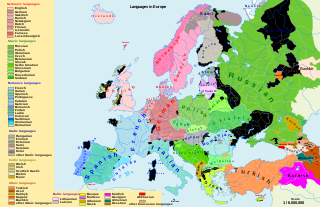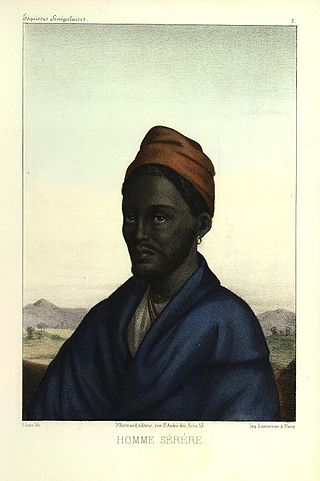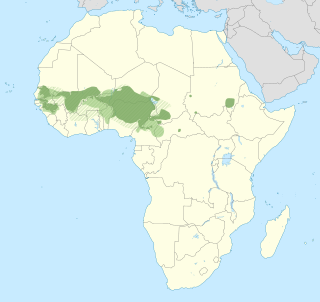Related Research Articles

There are over 250 languages indigenous to Europe, and most belong to the Indo-European language family. Out of a total European population of 744 million as of 2018, some 94% are native speakers of an Indo-European language. The three largest phyla of the Indo-European language family in Europe are Romance, Germanic, and Slavic; they have more than 200 million speakers each, and together account for close to 90% of Europeans.
Ethnologue: Languages of the World is an annual reference publication in print and online that provides statistics and other information on the living languages of the world. It is the world's most comprehensive catalogue of languages. It was first issued in 1951, and is now published by SIL International, an American evangelical Christian non-profit organization.

The West Atlantic languages of West Africa are a major subgroup of the Niger–Congo languages.

The Serer-Ndut or Ndut also spelt are an ethnic group in Senegal numbering 38600. They are part of the Serer people who collectively make up the third largest ethnic group in Senegal. The Serer-Ndut live mostly in central Senegal in the district of Mont-Roland, northwest of the city of ancient Thiès.

Fula, also known as Fulani or Fulah, is a Senegambian language spoken by around 36.8 million people as a set of various dialects in a continuum that stretches across some 18 countries in West and Central Africa. Along with other related languages such as Serer and Wolof, it belongs to the Atlantic geographic group within Niger–Congo, and more specifically to the Senegambian branch. Unlike most Niger-Congo languages, Fula does not have tones.

Senegal is a multilingual country: Ethnologue lists 36 languages, Wolof being the most widely spoken language.
Serer, often broken into differing regional dialects such as Serer-Sine and Serer saloum, is a language of the Senegambian branch of the Niger–Congo family spoken by 1.2 million people in Senegal and 30,000 in the Gambia as of 2009. It is the principal language of the Serer people, and was the language of the early modern kingdoms of Sine, Saloum, and Baol.

The Serer people are a West African ethnoreligious group. They are the third-largest ethnic group in Senegal, making up 15% of the Senegalese population. They are also found in northern Gambia and southern Mauritania.
The Senegambian languages, traditionally known as the Northern West Atlantic, or in more recent literature sometimes confusingly as the Atlantic languages, are a branch of Atlantic–Congo languages centered on Senegal, with most languages spoken there and in neighboring southern Mauritania, Gambia, Guinea-Bissau, and Guinea. The transhumant Fula, however, have spread with their languages from Senegal across the western and central Sahel. The most populous unitary language is Wolof, the national language of Senegal, with four million native speakers and millions more second-language users. There are perhaps 13 million speakers of the various varieties of Fula, and over a million speakers of Serer. The most prominent feature of the Senegambian languages is that they are devoid of tone, unlike the vast majority of Atlantic-Congo languages.
The Sere languages are a proposed family of Ubangian languages spoken in South Sudan and the Democratic Republic of the Congo. Several are endangered or extinct. The most populous Sere language is Ndogo of South Sudan, with about 30,000 speakers.

The languages of Mauritania mainly consist of various Afroasiatic languages, including: Zenaga-Berber, Tamasheq-Berber, Hassaaniya Arabic and Standard written Arabic. French is also used due to colonial influence. Some ethnic minorities speak Niger-Congo languages.
The Serer-Laalaa or Laalaa are part of the Serer ethnic group of Senegambia. They live in Laa, the Léhar Region, which comprises eighteen villages north of Thies and whose inhabitants are Serer-Laalaa. Although the people are ethnically Serer, their language Laalaa is not a dialect of the Serer-Sine language, but—like Saafi, Noon, Ndut and Palor, one of the Cangin languages.
The Serer-Noon also called Noon are an ethnic people who occupy western Senegal. They are part of the Serer people though they do not speak the Serer-Sine language natively.
Noon is a Cangin language of Senegal spoken in the Thiès region. There is an estimated population of 10,000- 50,000 speakers worldwide, rendering this language to be vulnerable. Ethnologue reports that it is 84% cognate with Lehar, essentially a divergent dialect, and 68% cognate with the other Cangin languages.
Kare is a southern Mbum language of the Central African Republic, spoken by the Kare people in the mountains of the northeasterly Ouham-Pendé prefecture around Bocaranga. It is spoken by around 97,000 people in the country, and another few thousand speakers in Cameroon. The language's presence on the southeastern edge of the Mbum family is thought to reflect early 19th-century migrations from the Adamawa Plateau, fleeing Fulani raids.
Palor is a language spoken in Senegal. The speakers of this language - the Palor people or Serer-Palor, are ethnically Serers but they do not speak the Serer-Sine language. Like the Lehar, Saafi, Noon and Ndut languages, their language is classified as one of the Cangin languages attached to the Niger–Congo family. Palor is closer to Ndut.
Lehar or Laalaa is one of the Cangin languages spoken in Senegal in the Laa Region, north of Thies as well as the Tambacounda area. The speakers are ethnically Serers, however just like the Ndut, Palor, Saafi and Noon languages, they are closely related to each other than to the Serer-Sine language. The Lehar language which is closer to Noon, is part of the Niger–Congo family. The number of speakers based on 2002 figures were 10,925.
The Palors also known as Serer-Palor, among other names, are an ethnic group found in Senegal around the west central, west southwest of Thiès. They are a sub-group of the Serer ethnic group found in Senegal, the Gambia and Mauritania. Although ethnically Serers, they do not speak the Serer language but one of the Cangin languages. Their language is Palor.

In The Gambia, Mandinka is spoken as a first language by 38% of the population, Pulaar by 21%, Wolof by 18%, Soninke by 9 percent, Jola by 4.5 percent, Serer by 2.4 percent, Manjak and Bainouk by 1.6 percent each, Portuguese Creole by 1 percent, and English by 0.5 percent. Smaller numbers speak several other languages. Gambian Sign Language is used by the deaf. English is the main language for official purposes and education.
References
- ↑ Not clear if date applies to Congolese population or only the total
- ↑ Sere at Ethnologue (10th ed., 1984). Note: Data may come from the 9th edition (1978).
- ↑ Sere language at Ethnologue (13th ed., 1996).